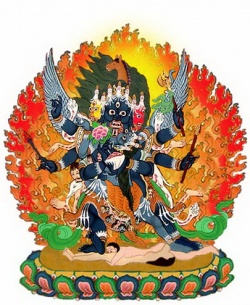Difference between revisions of "Murti Pooja"
(Created page with "thumb|250px| Murti Puja is one of the core concepts of Sanatana Dharma. The literal meaning of murti is ...") |
|||
| Line 1: | Line 1: | ||
[[File:Hayagriva Vajra01.jpg|thumb|250px|]] | [[File:Hayagriva Vajra01.jpg|thumb|250px|]] | ||
| − | [[Murti]] [[Puja]] is one of the core [[Wikipedia:concept|concepts]] of [[Sanatana Dharma]]. The literal meaning of [[murti]] is [[manifestation]], something that has taken a concrete [[form]]. [[Murti]] without any prefix refers to [[devata | + | [[Murti]] [[Puja]] is one of the core [[Wikipedia:concept|concepts]] of [[Sanatana Dharma]]. The literal meaning of [[murti]] is [[manifestation]], something that has taken a concrete [[form]]. [[Murti]] without any prefix refers to [[devata murti]] or god-form. Thus [[murti]] is a [[representation]] (in a [[manifest]], definite [[form]]) of god-form. [[Murti puja]] is {{Wiki|worship}} of [[murti]] as a god-form, {{Wiki|worship}} of god-form in the [[murti]]. The [[devotee]] worships the [[deity]] (or [[devata]]) who is requested to reside in the [[vigraha]] ([[murti]]) for the duration of the {{Wiki|worship}}. A [[murti]] usually is a concrete shape, having features attributed to the god-form. These are usually the [[physical]] [[attributes]] of the [[deity]] as described by the {{Wiki|theology}} for the [[Devata]]. The [[murti]] has as many hands/legs/heads as spoken of in {{Wiki|theology}}. Features like wearing snakes/garlands/having [[moon]] as adornment, the [[weapons]] they hold, are also reflected in the [[murti]]. |
{{R}} | {{R}} | ||
[http://www.hindupedia.com/en/Murti_Puja www.hindupedia.com] | [http://www.hindupedia.com/en/Murti_Puja www.hindupedia.com] | ||
[[Category:India]] | [[Category:India]] | ||
Latest revision as of 07:00, 22 December 2014
Murti Puja is one of the core concepts of Sanatana Dharma. The literal meaning of murti is manifestation, something that has taken a concrete form. Murti without any prefix refers to devata murti or god-form. Thus murti is a representation (in a manifest, definite form) of god-form. Murti puja is worship of murti as a god-form, worship of god-form in the murti. The devotee worships the deity (or devata) who is requested to reside in the vigraha (murti) for the duration of the worship. A murti usually is a concrete shape, having features attributed to the god-form. These are usually the physical attributes of the deity as described by the theology for the Devata. The murti has as many hands/legs/heads as spoken of in theology. Features like wearing snakes/garlands/having moon as adornment, the weapons they hold, are also reflected in the murti.
